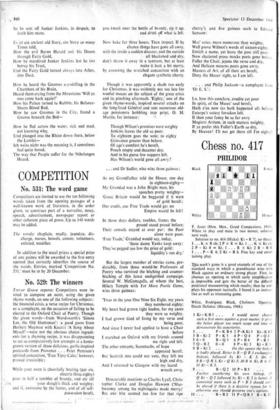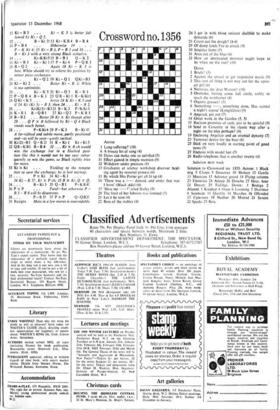Chess no. 417
PHILIDOR
Black White
8 men
F. Janet (Hon. Men., Good Companions. 1916; White to play and mate in two moves; solutioa next week.
Solution to no. 416 (Hicks): Kt — R 71, no threat 1...KxRch;2PXR=Kt.1...KxKtch.
2 P — Kt 8 = Kt. 1 . . . R X Kt; 2 R — B 8 1 . . . P — K 4; 2 Kt — B 6. Fine key and enter- taining play.
-1:11is,week's game is a good example of one of the standard ways in which a grandmaster wins with Black against an ordinary-strong player. First, he chooses an opening in which early simplification
„is impossible and gets the 'better of the difficult positional manoeuvring which results; then he out- plays his opponent tactically. I found it an instruc- tive as well as interesting game.
White, Rodriguez. Black, Cholmov. Opening Dutch Defence. (Havana, 1968:)
1 Kt—KB3 / would never choose
such a first move against a great Master; it gives the better player too much scope and time to demonstrate his superiority.
P—K B4 2 P—KKt3 Kt—K83 3 B—Kt 2 P—K 3 4P—Q4 P—Q4 50-0 B—Q 3 6P—B4 P—B 3 7 Q — B 2 0 — 0 8 P — Kt 3 Kt R 3
9 B — Kt 2 . . . On this square the bishop is badly placed. Better is B — Q R 3 exchangitn: bishops, followed by Kt — K 5. Or, 11 9 B — Q R 3, Ki — Q Kt 5; 10 B x Kt, B x II Kt — K 5.
B — Q 2 10 P — B 5 . . . Further smothering his own bishop. 10 Q Kt — Q 2 followed by Kt — K 5 is better. A committal move such as P — B 5 should old% be played if there is a decisive reason for n otherwise one should preserve one's options.
10 . . . B—B2 11 P—QR 3 B—K 1!
12 Kt - B 3 ,
lowed by Kt - Q 2.
12 . . . B- Kt 3113 Kt-KR 4 B - R 4
14 P - B 4 . Otherwise 14 . . . p - K Kt 4; 15 Kt - B 3, P - R 3 and 16 . . . B - Kt 3 with a very strong Black initiative.
14 . . . Kt-KKt515 B- B 1 Q - K 2 16 Kt - B 3 Kt - Kt 117 P - Kt 4 P - Q R 3
18 B - Q 2 . . . Again 18 Kt - K 5 is best. White should try to relieve his position by minor piece exchanges.
18 . . . Kt - Q 2 19 Kt - Q 1 QKt-B3
20 Kt - Kt 2 . . . Better Kt - K 3; White is too optimistic.
20 . . . Kt-K521 Kt-Q3 K-R 1 22 P-QR 4 B-K 1 23 QR-Ktl R-KKt1
24 Q Kt - K 5 . . . better 24 K Kt - K 5 and if 24 Kt (Kt 5) - B 3, then 24 . . Kt - B 2.
24 . . . Kt(Kt5)-B3 25 B-K 3 P2KKE3 26 K-R 1 R-QBI 27 Kt-Q2 P-KR 3 28 B - B 2 . . . Better 28 Kt X Kt though after 28 ...QP X B followed by Kt - Q 4 Black stands much better.
28 . . . P-KKt4 29 P-K 3 B - Kt 1! A far-sighted and subtle move, partly positional and—as will be seen—partly tactical.
30 Kt (2)- B 3 Q - R 2! 31 R - Kt I Kt - Kt 5
32 QR-KBI B-R 4 32 . . . Kt X B ch would win the exchange but in a blocked posi- tion like this it would not be too easy subse- quently to win the game, so Black rightly tries for more.
33 Kt X Kt • • • Yielding to the tempta- tion to save the exchange; he is lost anyway.
33 . . . P x Kt 34 Kt -K 1 . . .
34 Kt - K 5?, Kt x P ch; 35 B X Kt, Q X Q.
34 . . . B-Kt 3 35 Q-B 1 P-KR4!
36 P X P . . . Fatal—but otherwise P -
R 5 - R 6 will be disastrous.
36. . . P - R 5! 37 P x P Q-QB2!
38 Resigns Mate in a few moves is unavoidable.
Kt - K 5 is better fol-















































 Previous page
Previous page